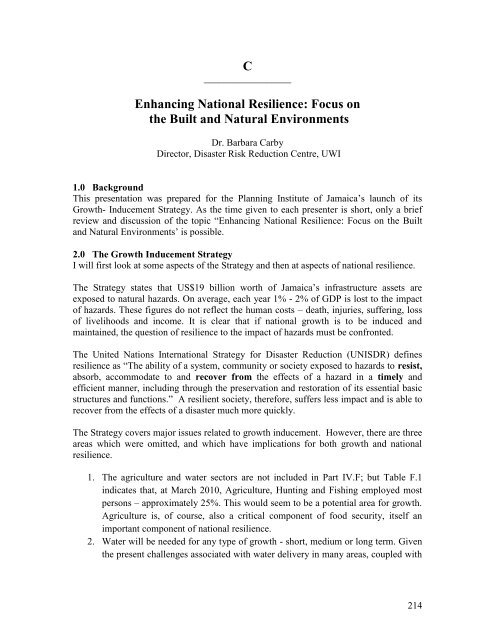PIOJ Growth-Inducement Strategy - Planning Institute of Jamaica
PIOJ Growth-Inducement Strategy - Planning Institute of Jamaica
PIOJ Growth-Inducement Strategy - Planning Institute of Jamaica
You also want an ePaper? Increase the reach of your titles
YUMPU automatically turns print PDFs into web optimized ePapers that Google loves.
C<br />
__________________<br />
Enhancing National Resilience: Focus on<br />
the Built and Natural Environments<br />
Dr. Barbara Carby<br />
Director, Disaster Risk Reduction Centre, UWI<br />
1.0 Background<br />
This presentation was prepared for the <strong>Planning</strong> <strong>Institute</strong> <strong>of</strong> <strong>Jamaica</strong>’s launch <strong>of</strong> its<br />
<strong>Growth</strong>- <strong>Inducement</strong> <strong>Strategy</strong>. As the time given to each presenter is short, only a brief<br />
review and discussion <strong>of</strong> the topic “Enhancing National Resilience: Focus on the Built<br />
and Natural Environments’ is possible.<br />
2.0 The <strong>Growth</strong> <strong>Inducement</strong> <strong>Strategy</strong><br />
I will first look at some aspects <strong>of</strong> the <strong>Strategy</strong> and then at aspects <strong>of</strong> national resilience.<br />
The <strong>Strategy</strong> states that US$19 billion worth <strong>of</strong> <strong>Jamaica</strong>’s infrastructure assets are<br />
exposed to natural hazards. On average, each year 1% - 2% <strong>of</strong> GDP is lost to the impact<br />
<strong>of</strong> hazards. These figures do not reflect the human costs – death, injuries, suffering, loss<br />
<strong>of</strong> livelihoods and income. It is clear that if national growth is to be induced and<br />
maintained, the question <strong>of</strong> resilience to the impact <strong>of</strong> hazards must be confronted.<br />
The United Nations International <strong>Strategy</strong> for Disaster Reduction (UNISDR) defines<br />
resilience as “The ability <strong>of</strong> a system, community or society exposed to hazards to resist,<br />
absorb, accommodate to and recover from the effects <strong>of</strong> a hazard in a timely and<br />
efficient manner, including through the preservation and restoration <strong>of</strong> its essential basic<br />
structures and functions.” A resilient society, therefore, suffers less impact and is able to<br />
recover from the effects <strong>of</strong> a disaster much more quickly.<br />
The <strong>Strategy</strong> covers major issues related to growth inducement. However, there are three<br />
areas which were omitted, and which have implications for both growth and national<br />
resilience.<br />
1. The agriculture and water sectors are not included in Part IV.F; but Table F.1<br />
indicates that, at March 2010, Agriculture, Hunting and Fishing employed most<br />
persons – approximately 25%. This would seem to be a potential area for growth.<br />
Agriculture is, <strong>of</strong> course, also a critical component <strong>of</strong> food security, itself an<br />
important component <strong>of</strong> national resilience.<br />
2. Water will be needed for any type <strong>of</strong> growth - short, medium or long term. Given<br />
the present challenges associated with water delivery in many areas, coupled with<br />
214
















